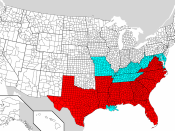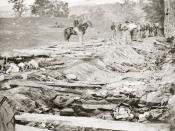Antietam: America's Bloodiest Day When you think of the greatest and most tragic events in American history, what do you think of? Probably the Titanic or Pearl Harbor. This, although being a matter of opinion, is not true. The battle of Antietam is the bloodiest day in American history.
September 16, 1862, we can only imagine the thoughts that were running through the heads of soldiers. This is a journal entry written by Thomas Livermore the night before the battle.
"Whether we were to attack or to repel, whether the fight was to be in the woods on our right in the ravine, or in the hills in our front, or on the crest amid the hostile batteries, I knew not, and then, when was the fight to begin? How long would it last? Who would win? Was I to be killed, to be torn by a shell, or pierced with a bullet? What was death? How quickly should I be in the other world if I were killed? I am not aware that I once wished we should not fight.
I know that to stay out or shrink from the battle in any way never entered my head; yet I can venture to say that while we waited in the twilight, time flew by on slow wings, and the quicker I was in it and through it, alive or dead, the better I thought I would be. This contemplating for a long time the black-muzzled cannon, and conjuring up the host who are to blaze at you with death-dealing musketry, is not pleasant." September 17, 1862, Union and Confederate soldiers woke and met each other about four miles from Sharpsburg Maryland. General Robert E. Lee positioned his army in a semicircle along the Potomac River. The Union army under command of General McClellan lined on the hills above them. The first advance was made shortly after dawn, 5:00 am, by the Union who attacked the Confederates left flank and center. The odds were 35,000 against 87,000 in the north's favor. The Union army pushed the Confederate army back into a sunken road that is now known as Bloody Lane. Here the most violent fighting of the battle took place. With the Southern army defending, anyone moving toward or away from Bloody Lane was a good target. Yet around 9:30 am the Second Irish Brigade took control of the road, and even though the Confederates were weak and retreating, General McClellan did not take advantage and push forward towards Sharpsburg. After almost five hours of fighting, 12,000 men lie dead or wounded with no ground lost or gained by either side.
The next stage of the battle was fought at Burnside Bridge four miles south of Sharpsburg. Here General Burnside brought massive reinforcements who would fight the exhausted and weak Confederate army. Yet little did he know that general A.P.Hills division was also moving toward Sharpsburg to defend the southerners ground. The two divisions arrived at nearly the exact same time to Sharpsburg. Here the rest of the battle was fought until approximately 8:00 pm.
From 5:00 am to 8:00 pm, after almost 16 hours of fighting, neither side actually won the battle. It was a draw, and 23,000 men died for it. This is more than the three previous wars; the Revolution, Mexican War, and the War of 1812; combined. It is said that you could walk through the cornfields and riverbanks without touching the ground. You would only be walking on the dead that lined them.
Impact of Antietam The main problem was that the Union soldiers had nothing to fight for. Yet the Confederates had everything to fight for. They were being attacked near their homes and were fighting for the South. Many of the Union soldiers believed the south had the right to secede and didn't feel it necessary to restore the Union solely with force. At this point the war was waged as a major disagreement over State's rights with slavery spurring on the issue, but slavery was not the main issue.
Lincoln was faced with a difficult decision and one that would inevitably restore the Union, he announced the Emancipation Proclamation to free the slaves. This gave the Union something to fight for. It also kept Europe from supporting the South, which isolated the Confederacy. The greater impact of the Emancipation Proclamation was that it was also a major step in eliminating the practice of slavery in the United States, and would eventually restore the Union.





